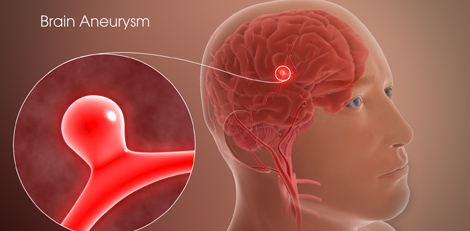Brain Aneurysm - symptoms, risk factors and treatments etc - Important things to know!!

In some persons, there will be a bulging weak area in the blood vessels in their brain and this is termed as brain aneurysm. It is noteworthy that the weakness in the artery wall might lead to the rupture of cerebral aneurysm. As a result, there would be bleeding in the brain. Point is that brain aneurysm is also known as cerebral aneurysm. There are 3 types of aneurysm such as berry or saccular aneurysm, fusiform aneurysm, mycotic aneurysm.
Symptoms observed:
It is worth mentioning that as such brain aneurysms do not lead to any symptoms but those which have ruptured could lead to severe headaches. Bitter truth is that this kind of headache is the worst ever kind of headache experienced by the patients. Various other symptoms associated with brain aneurysms are nausea, vomiting, stiff neck, blurred vision, light sensitivity, seizure etc.
There are also few symptoms associated with unruptured aneurysm and these are pain above and behind one eye, dilated pupil, numbness on one side of the face and vision change or double vision etc.
Who is at risk of getting brain aneurysms?
Weakness of the artery wall might be due to many important reasons. It is believed that these factors could increase the risk of getting brain aneurysm or aneurysm rupture etc.
Various risk factors are
Old age:
Though brain aneurysms can take place in a person at any age, but mostly it occurs between 30 and 60.
In females:
It is important to note that brain aneurysms occur mostly in women when compared to men.
Smoking:
Smoking cigarettes can cause many health issues is known. Brain aneurysm can also be due to smoking.
High blood pressure:
Arteries would get weakened in those who have high blood pressure or BP. As a result, aneurysm could occur and rupture in weakened arteries. Managing blood pressure is highly essential.
Drug usage:
It must be noted that frequent drug use would cause blood pressure to shoot up. Intravenous usage of illicit drugs could lead to infection. ThThis could further lead to mycotic aneurysm.
Inherited connective tissue disorders:
The blood vessels could also break due to inherited connective tissue disorders like Ehlers- Danlos syndrome.
Polycystic kidney disease:
It must be taken into account that this disorder could lead to fluid filled sacs in kidneys. Blood pressure might get increased leading to brain aneurysm.
Family history:
If any family members have a brain aneurysm, then there are more chances of getting a brain aneurysm. In such a scenario, it would be better to get screened for brain aneurysms.
How is brain aneurysms diagnosed?
It is worthy to note that persons with unruptured brain aneurysms would not know that they have this issue in them. By means of CT scan or MRI etc, healthcare providers could detect the brain aneurysm.
Treatment for brain aneurysm:
Surgical procedure is mostly used to treat persons with brain aneurysm that have ruptured or at huge risk of getting ruptured. Truth is that preventive surgery is recommended only when there is a huge risk of rupture. For treating unruptured aneurysms, a risk assessment would be done to assess the need for surgery. Factors like age, aneurysm size, location of aneurysms and other health conditions etc would play a huge role in the assessment process.







